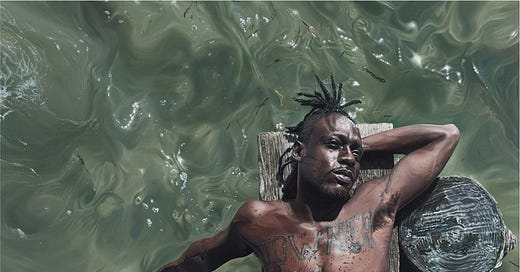Towner for Life
Calida Rawles first solo exhibition showing at the Perez Art Museum in collaboration with Black Girls in Art Spaces

During Miami Art Week, there was an event held with the Perez Art Museum and Black Girls in Art Spaces highlighting Los Angeles artist Calida Rawles solo exhibition Away With The Tides. Each portrait, young and old, depicted residents of Miami’s Overtown, originally called “Colored Town”, engulfed in free moving bodies of water. Every piece became its own commentary: on Black people and their relationship with the Atlantic, the murky history of gentrification and systemic racism in Miami, the beauty created in the depths of oppression, and the livelihood that exists despite it all.
It’s a shame that I missed some of this introduction. I miscalculated the time it took to wait for the metrorail, transfer to the inner loop at Government Center, getting off at College Bayside for the Omni Loop, giving up on taking it after seeing how packed the cart was of confused tourists and tired locals, and letting my feet hurt trying to walk in shoes only meant for posing in pictures to the Perez Art Museum that sits on the edge of Museum Park. After finally making it on time, only by Miami’s standards, I found the private tour in the gallery dedicated to Calida Rawles’ exhibition. My platform sandals made my arrival known without my consent.
Standing in the gallery alongside other heads of afros, we looked at Rawles' piece Towner for Life –a hyper realistic style portrait hung against a broad burgundy expanse. Water wrestles with uncertainty, its murkiness as clear as seaweed floating through its waves. A man lays resting on a sun-bleached wooden dock: his head rests carefree under his palm, locs tied up in a pineapple bun, his other hand sways with the water beneath him, swirling his pattern of glistening light on its surface, chest up to an unseen sun lights up words etched into his dark skin “Towner 4 Life”. Engrained is his story, his city’s history, that in this moment they become one. His body is matrimony to times and woes Miami does its best to dismiss. Contrasting his body's relaxed state, he gazes off into the distance with uncertain eyes –it’s difficult to decipher.
Marten Elder is the subject of this portrait. Rawles took Elder's photo at Virginia Key Beach, a place that used to be a Blacks-only beach from 1945 to the early 1960s. Elder is a resident of Overtown and has lived there his whole life. Our tour guide mentioned that on the day of the exhibit's opening, he made a guest appearance and it was his first time seeing the portrait too.
There was a short film, her first, made by Rawles and was commissioned by, and for, the Perez Art Museum that featured Elder. In a room made up of three LED panels, with seating being four cubes, Elder is seen bobbing in the waters of Theodore Gibson Park’s public pool. A montage of photos and videos of Virginia Key’s segregated history, a map of Overtown, found footage of its residents partying, their homes being torn down, and video of present day Overtown's buildings and residents is all projected onto these screens. It was overwhelming to see all this at once. Nothing was left to the imagination of anyone viewing this film. Rawles made an overt effort in showcasing the life that has persisted in Overtown despite decades of systemic racism, gentrification, red lining, segregation and the multitudes of ways America has tried to oppress Black Americans. Unfortunately I did not make note of this film’s name but I found it to still be worth mentioning.
As the conversations of this private tour began to taper off, I found myself being gravitated toward conversation. A woman with the prettiest defined curls, and the clearest skin I'd seen smiled at me, and I returned it with practiced politeness. We spoke about the art, our thoughts being similar lines of thinking as we discussed the details of “Towner for Life”. Our conversation quickly became less formal when we found out that we each claimed Miami –some of the women there were from as far out as London. She now lives in New York, occupying her time with their art scene there. I told her of my own interest to leave Miami, expressing my love-hate relationship with it, hating how hyperaware I am of how bubble-like this city can be. We talked about the rampant gentrification of neighborhoods like Wynwood and Little Haiti, the increase in traffic, how rush hour isn’t an hour but stretches from 4pm to 6:30pm, and the lack of beauty supply stores. Amidst this, we still bonded over our love for a good Cuban coffee and partying at Shrine –ultimately our love for this city.
For as much as we might not want to live here, a part of us will always stay. Rawles’ thesis for this exhibition was to demonstrate a study on Overtown’s history and its residents, spending time with the subjects of her paintings and getting to know them. She tied her style of hyperrealism and motif of water to the history this city has with its Black residents in a way that flows into the fabric of our own conversation. It seems that we’re water birthed babies flailing for land that sees us fit. Our hearts are stuck below sea level, learning to walk as fast as swimming –even if those spaces may have once been limited.
If you enjoyed reading this, feel free to leave a like and comment (or email) your thoughts. Have a nice day!




